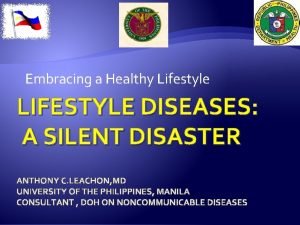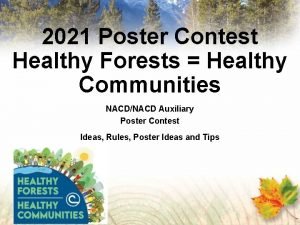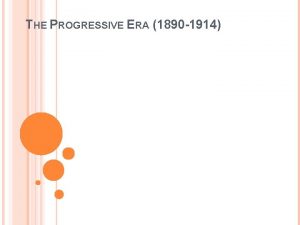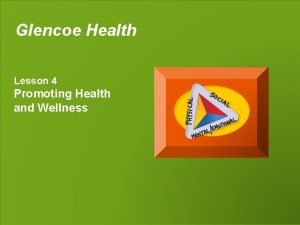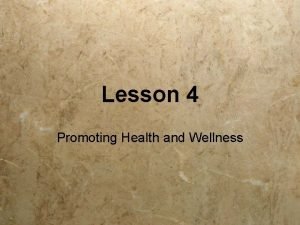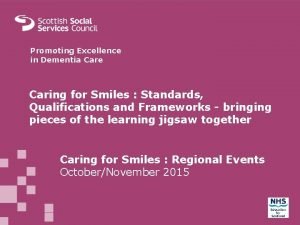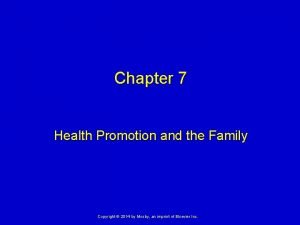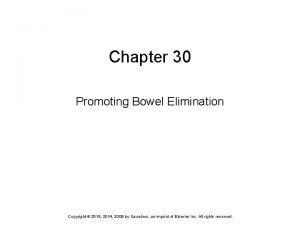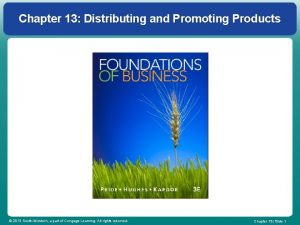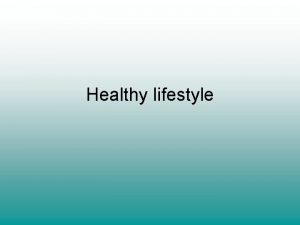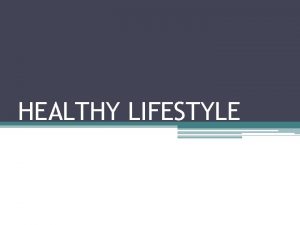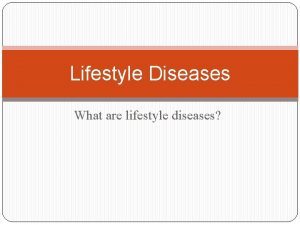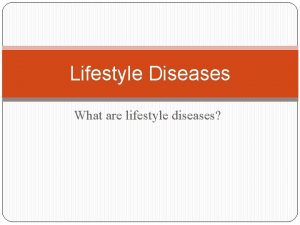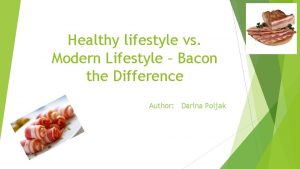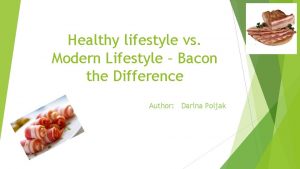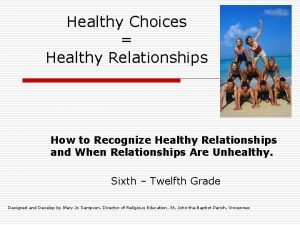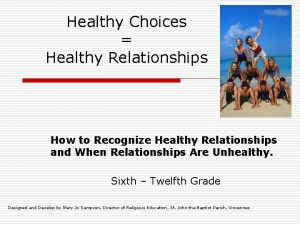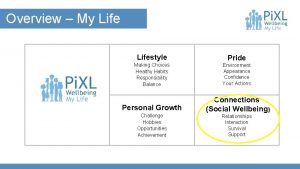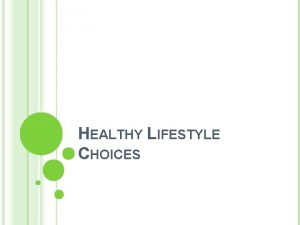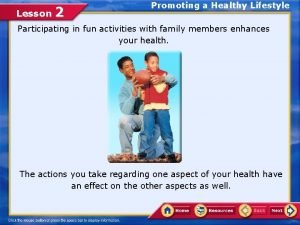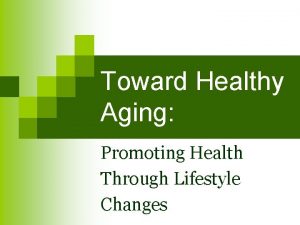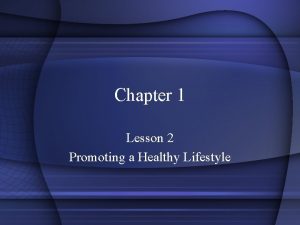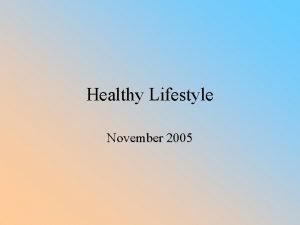12 2 Promoting Healthy Systems Healthy lifestyle choices
























- Slides: 24

12. 2 Promoting Healthy Systems

Healthy lifestyle choices • One of the best defenses again disease is to have a healthy lifestyle that includes regular exercise, a good diet, sleep and avoiding toxic substances such as cigarette smoke

Common Respiratory Disorders • Colds – Result of viral infection – Sometimes accompanied by sinusitis • Sinusitis – Can also be caused by bacteria – Symptoms include stuffy/runny nose swelling around the eyes and cheekbones, sense of pressure • Lack of sleep, allergies, stress, diet, exposure to smoke can reduce your ability to resist being infected by colds or sinusitis

Common Respiratory Disorders • Influenza, commonly called the ‘flu’ – Common viral infection of the upper respiratory system • Pneumonia – Can result from a viral (flu) or bacterial infection of the lungs • Also fungi and parasites – The alveoli fill with fluid which prevents gas exchange

Common Respiratory Disorders • Asthma is a chronic disorder of the bronchi and bronchioles – They become narrower which restricts air flow • Can be life threatening • There are many environmental triggers • Treatment usually include a ‘puffer’ that contains a bronchodilator (a steroid)

Common Respiratory Disorders • Bronchitis is an inflammation of the bronchi that produces excess mucus resulting in coughing and difficulty breathing – There are many environmental triggers – May last for years • Makes the heart work harder to supply the body with adequate amounts of oxygen


Common Respiratory Disorders • Emphysema mean to ‘puff up’ in Greek – Refers to “overinflated lungs” – The cilia become damaged and can’t adequately clear the bronchioles which become clogged – Air pressure build up which eventually tears the alveoli apart reducing the surface area for gas exchange • Caused by exposure to smoke and workplace chemical hazards


Common Respiratory Disorders • Chromic Obstructive Pulmonary Disease (COPD) – Occurs when chronic bronchitis and emphysema occur together – Treatment includes and increased oxygen supply and medication – If untreated can lead to respiratory failure

Common Respiratory Disorders • Cystic Fibrosis is a fatal genetic disease – Abnormally thick mucus is produced in the lungs and digestive systems • Mucus is difficult to dislodge – 1 in 3600 children in Canada are born with this – In 1989 Lap-Chee Tsui (U of T and Sick Kids) identified the gene • Research is ongoing for a cure

Common Respiratory Disorders • Severe Acute Respiratory Syndrome (SARS) – Caused by a corona virus this disease causes a serious pneumonia like illness • Breathing becomes difficult and is often fatal

Common Respiratory Disorders • Lung Cancer – 85% of these are linked to smoking – Uncontrolled growth of cells results in tumours – Can be treated by surgery, radiation and chemotherapy and possibly transplant*



Smoking • Cigarette smoke contains small carbon particles that are coated with toxic chemicals – Over time this creates a thick tar like coating on the cilia so they no longer work • “smoker’s cough” is the result of trying to clear the mucus because the cilia don’t work – The contact of toxic chemicals with the cells of the lungs cause mutations to those cells creating malignant tumours • These often metastasize and cause cancer in other parts of the boy

Smoking • Research has shown that exposure to second hand smoke can be as dangerous as smoking • There are huge benefits to stopping : – Within 8 hours • Carbon monoxide levels drop • Oxygen levels increase to normal – Within 48 hours • Your chances of having a heart attack start to go down • Your sense of smell and taste improve

Smoking • There are huge benefits to stopping : – Within 72 hours • Your bronchial tubes relax and make breathing easier • Your lung capacity increases – Within 2 weeks to 3 months • Your blood circulation improves • Your lung function increases by 30% – Within 6 months • Your coughing, tiredness and shortness of breath improves

Smoking • There are huge benefits to stopping : – Within 1 year • Your risk of smoking related heart attack is cut in half – Within 10 years • Your risk of dying from lung cancer is cut in half – Within 15 years • Your risk of dying from a heart attack is the same as a person who never smoked.

Diabetes • This is a group of diseases where a high level of blood glucose build up as the result of problems with insulin secretion, insulin action or both – Discovered by Banting and Best in 1921 (U of T) – Insulin is a hormone that makes cells permeable to glucose (blood sugar) • Since cells are always undergoing cellular respiration there is a constant need for blood sugar

Diabetes • An inability to take glucose into the cells results in fatigue – Long term effects can include kidney problems, blindness, heart disease, poor circulation resulting in amputation etc. • Type 1 Diabetes – Caused when the pancreas is damaged – Can not be prevents but can be controlled

Diabetes • Type 2 Diabetes – Body cells do not respond properly to insulin – The incidence of this type is increasing at an alarming rate • Linked to obesity, sedentary lifestyle

Diabetes • Treatment of diabetes is synthetic insulin injections, close monitoring of blood glucose levels, increased physical activity and a better diet

Reducing the risk of Type 2 • • • Don’t smoke Have an active lifestyle Maintain a healthy weight Limit intake of fat and sugar Keep cholesterol and blood fats within recommended levels • Maintain normal blood pressure • Eat regular balanced meals
 Lecture on healthy lifestyle
Lecture on healthy lifestyle Healthy living sentences
Healthy living sentences Moodboard healthy lifestyle
Moodboard healthy lifestyle Marita leachon
Marita leachon Chapter 9 making healthy food choices
Chapter 9 making healthy food choices Chapter 1 lesson 2 our economic choices worksheet answers
Chapter 1 lesson 2 our economic choices worksheet answers Journal on healthy food healthy mind
Journal on healthy food healthy mind Healthy soil healthy life poster ideas
Healthy soil healthy life poster ideas Healthy forests healthy communities poster contest
Healthy forests healthy communities poster contest Healthy nurse healthy nation
Healthy nurse healthy nation When was the progressive era? *
When was the progressive era? * Promoting services and educating customers
Promoting services and educating customers Promoting alternative thinking strategies
Promoting alternative thinking strategies Glencoe health and wellness
Glencoe health and wellness Promoting family earthquake preparedness
Promoting family earthquake preparedness Lesson 4 promoting health and wellness
Lesson 4 promoting health and wellness Promoting racial literacy in schools
Promoting racial literacy in schools Lesson 4 promoting health and wellness
Lesson 4 promoting health and wellness Methods of promoting intrapreneurship leaving cert
Methods of promoting intrapreneurship leaving cert Promoting infant health section 7-2
Promoting infant health section 7-2 Promoting excellence in dementia care
Promoting excellence in dementia care Deontological theories
Deontological theories Chapter 7 promoting health and wellness
Chapter 7 promoting health and wellness Promoting bowel elimination
Promoting bowel elimination Chapter 13 distributing and promoting products
Chapter 13 distributing and promoting products



